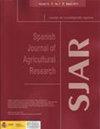热应激和身体状况评分对荷斯坦奶牛产褥期疾病发生的影响
IF 0.8
4区 农林科学
Q3 AGRICULTURE, MULTIDISCIPLINARY
引用次数: 0
摘要
本研究的目的:评估热环境中荷斯坦奶牛产仔和胎盘滞留时的温湿度指数(THI)和身体状况评分(BCS)、产褥期子宫炎、临床酮症和乳腺炎之间的关系研究区域:墨西哥东北部。材料和方法:这是一项使用单变量逻辑回归的回顾性队列研究(2017年1月至2021年12月,12102名哺乳期妇女)。结果变量是围产期疾病,预测变量是BCS和产仔时的热应激。主要结果:THI>82产仔的奶牛患RP的可能性比在中度或低度热应激(THI<82单位)下分娩的奶牛高30%(患病率16.8%vs13.7%;p<0.01)。与THI<82产仔的奶牛相比,THI>82产仔奶牛患子宫炎的几率显著增加(患病率15.6 vs 13.4;p<0.01)。产仔时BCS≥3.5的奶牛患RP的风险是BCS<3.5的奶牛的一半(患病率10.4vs19.1%,p<0.01)。同样,当产仔时BCS≥3.5时,患子宫炎的风险降低(p<0.01)(患病率10.9vs 17.4%)。研究强调:与分娩时轻度或无热应激的奶牛相比,产仔时的热应激与RP、产褥期子宫炎和临床酮症的风险增加有关。此外,BCS≥3.5的奶牛不太可能出现RP和子宫炎,但高体脂与临床酮症的风险增加有关。本文章由计算机程序翻译,如有差异,请以英文原文为准。
Effect of heat stress and body condition score on the occurrence of puerperal disorders in Holstein cows
Aim of the study: To evaluate the association between temperature-humidity index (THI) and body condition score (BCS) at calving and retained placenta (RP), puerperal metritis, clinical ketosis, and mastitis in Holstein cows in a hot environment
Area of study: Northeastern Mexico.
Material and methods: This is a retrospective cohort study (n= 12,102 lactations from January 2017 to December 2021) using univariate logistic regressions. The outcome variables were periparturient diseases, and the predictor variables were BCS and thermal stress at calving.
Main results: Cows calving with a THI > 82 were 30% more likely (prevalence 16.8% vs 13.7%; p < 0.01) to have RP than cows whose parturition occurred with moderate or low thermal stress (THI < 82 units). Cows calving with THI > 82 had significantly increased chances of having metritis than cows calving with THI < 82 (prevalence 15.6 vs 13.4; p < 0.01). Cows calving with a THI > 82 were 1.8 times more likely to have clinical ketosis (7.6% vs 4.4%; p < 0.01) than cows calving with THI < 82 units. Cows with BCS at calving ≥ 3.5 had half the risk of having RP (prevalence 10.4 vs 19.1%, p < 0.01) than cows with BCS < 3.5. Likewise, the risk of metritis decreased (p < 0.01) with BCS ≥3.5 at calving (prevalence 10.9 vs 17.4%).
Research highlights: Heat stress at calving was associated with an increased risk for RP, puerperal metritis, and clinical ketosis compared to cows undergoing mild or no heat stress at parturition. Also, cows with BCS ≥ 3.5 were less likely to present RP and metritis, but high body fatness was associated with an increased risk for clinical ketosis.
求助全文
通过发布文献求助,成功后即可免费获取论文全文。
去求助
来源期刊

Spanish Journal of Agricultural Research
农林科学-农业综合
CiteScore
2.00
自引率
0.00%
发文量
60
审稿时长
6 months
期刊介绍:
The Spanish Journal of Agricultural Research (SJAR) is a quarterly international journal that accepts research articles, reviews and short communications of content related to agriculture. Research articles and short communications must report original work not previously published in any language and not under consideration for publication elsewhere.
The main aim of SJAR is to publish papers that report research findings on the following topics: agricultural economics; agricultural engineering; agricultural environment and ecology; animal breeding, genetics and reproduction; animal health and welfare; animal production; plant breeding, genetics and genetic resources; plant physiology; plant production (field and horticultural crops); plant protection; soil science; and water management.
 求助内容:
求助内容: 应助结果提醒方式:
应助结果提醒方式:


